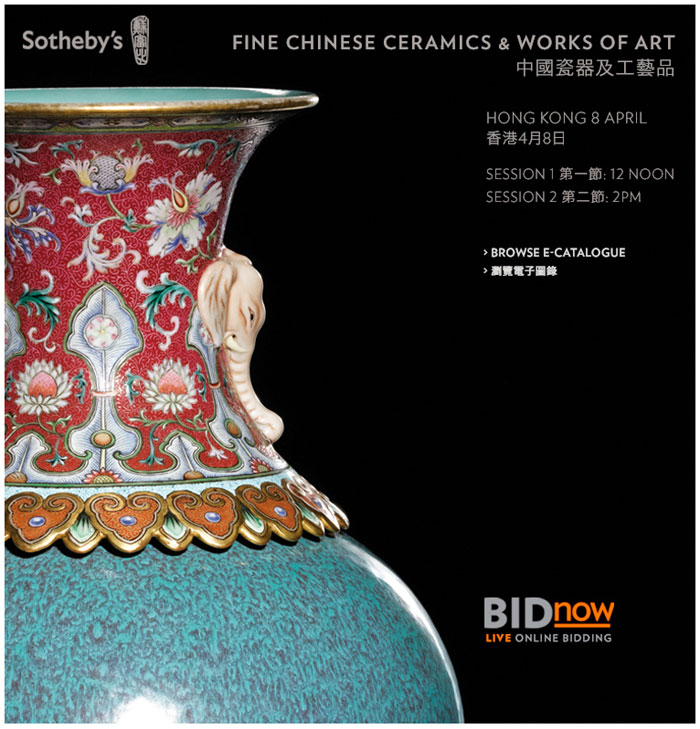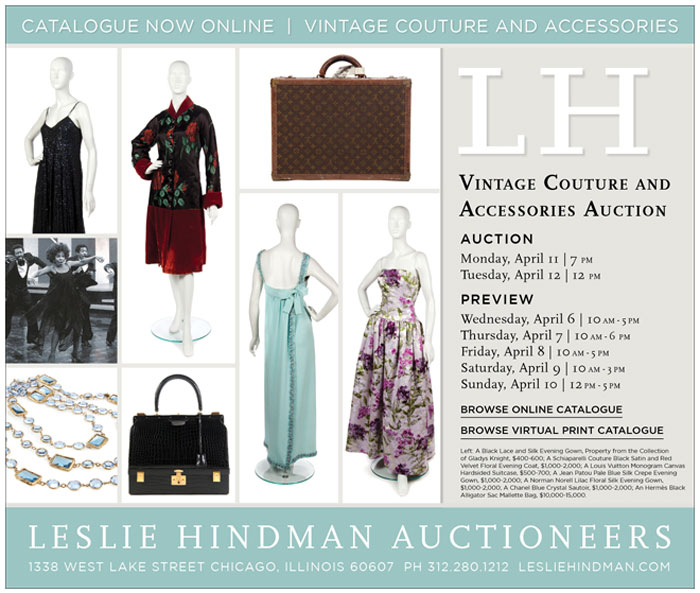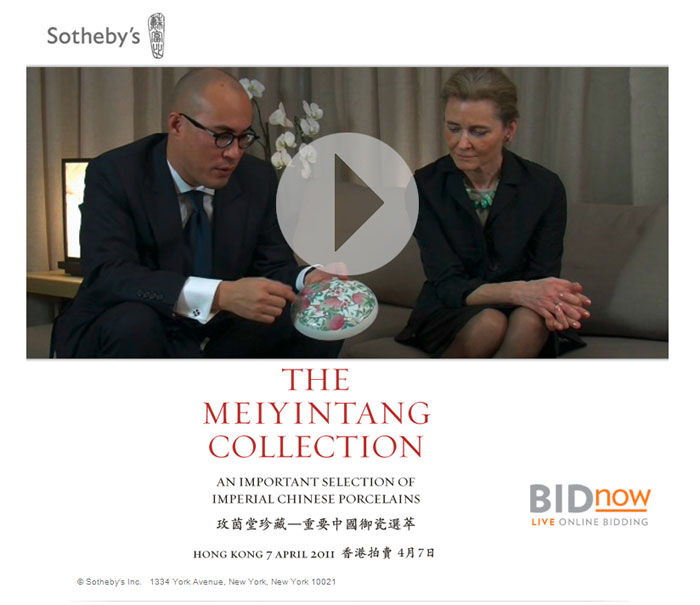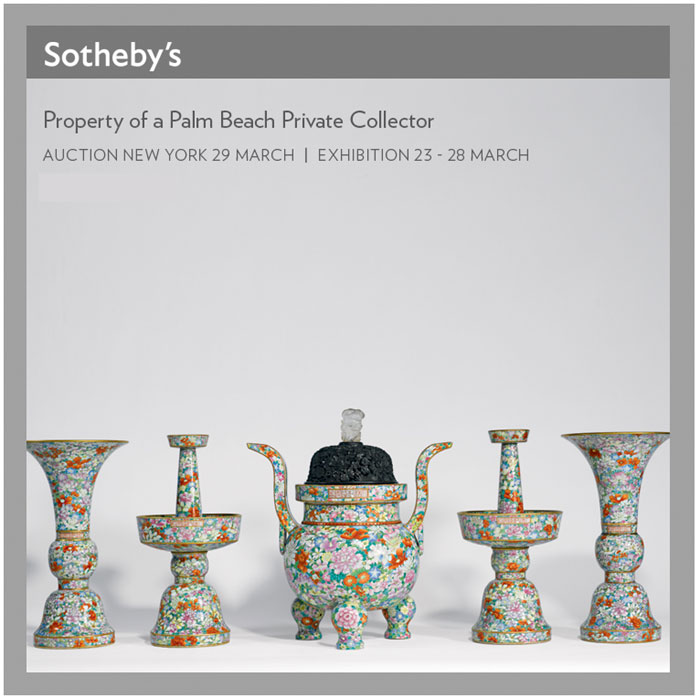Antiques
Sotheby’s – Fine Chinese Ceramics & Works of Art
March 31st, 2011 by adminAmong the highlights of the spring Fine Chinese Ceramics and Works of Art sale is a selection of Imperial porcelain vases. A rare pair of gold enameled archaistic vases imitating bronze hu vessels, produced for the Qianlong Emperor (r. 1736-95) epitomizes the opulence of his reign. The pair of vases appears to be unique and no other examples are recorded.
As always, the Chinese Ceramics and Works of Art sale in Hong Kong this spring will bring only the finest and rarest objects to the market. Through the many pieces of historical treasures offered in this sale, collector can trace the splendors of the archaic Chinese art.
Leslie Hindman Auctioneers
March 27th, 2011 by adminClick here to browse the full catalogue for the Vintage Couture And Accessories Auction. There will be two opportunities to view this beautiful collection at auction:
Auction: April 11th – 7:00 pm
Auction: April 12th – 12:00 pm
Charleville Muskets and Antique American Firearms
March 24th, 2011 by adminContributed by www.Marks4Antiques.com – a membership-based service specializing in providing identification & appraisal advice on antiques & collectibles.
To find prices and values for Antique Rifles or Firearms and Militaria or Civil War collectibles of all types or styles and periods, please visit Values4Antiques.com service to search through millions of auction records to compare with yours.
The best of smooth-bore Muskets of colonial and Revolutionary days were the Charleville muskets of France. From 1717 to 1777, they were constantly being improved. French muskets previous to the model 1763 were extensively used by French troops in this country and Canada during the early colonial wars, and demonstrated their superiority over contemporary British muskets, which remained practically the same from early colonial times until long after the Battle of Waterloo. After the embargo of 1774, no British arms were allowed here, except for those in the hands of British troops.
The Charleville muskets were made in St. Etienne, Tulle, and Mauberge, besides Charleville itself. The first one, model 1717, measured 62 1/2 inches, with a barrel length of 46 7/8 inches, the barrel being secured by four pins and one iron band situated a third of the way from the muzzle to the vent hole. This model had a walnut stock made with a high comb; round sling swivels mounted on the left side, one at the band and the other in an eye in the stock Just to the rear of the side plate; a flat lock plate, with the rear edge oval; and a thin butt plate secured by pins and a screw. All mountings were of iron. An iron strap or tenon connected the frizzen screw with the frizzen spring screw – a unique feature in this lock. The hammer was flat and goose-necked, with beveled edges. The ramrod was of wood.
The next Charleville was the model 1728, the measurements of which were the same as the model 1717. The rear of the barrel was finished off with eight flat faces, the top one extending to within six inches of the muzzle, the others each five inches in length. A rigidity stud on the under side of the barrel extended into a notch in the stock. The barrel was secured by three bands, the upper one with two rings over the barrel and a spring to the rear, the middle one with a projection on the under side. All the fittings of the model 1728 were of iron and of light construction to guide the ramrod, held by friction. The lower one, also held by friction, was beck shaped at the bottom. The lock plate, flat-faced with a point to the rear, measured 6 1/2 inches by 2 3/8 inches. The hammer was flat and goose-necked, and the jaw screw was notched. The walnut stock, of rather light construction, had a deep comb and a decided drop.
All the fittings of the model 1728 were of iron and of light construction. The iron pan had three flat faces, a fence at the rear, and a tenon to the frizzen screw. The trigger guard was 11 5/8 inches long and finished with ball points at the ends. The lower swivel ring was secured by an eye in the left of the stock just to the rear of the side plate, the upper one by the middle band. The ramrod of the 1728 and all succeeding models was of iron.
The next model, the 1746, was much the same as the one preceding, except that the rear of the barrel was octagonal, the rear of the lock plate convex, and the muzzle band shorter.
The model 1754 was a great improvement over preceding weapons. The total length was reduced to 56 inches and the barrel length to 41 inches, with a uniform weight of 10 1/4 pounds. Officers’ guns were still further reduced to 7 pounds, with a total length of 54 inches. Oval sling rings were placed under the stock, one at the trigger guard and the other at the middle band. The muzzle band was greatly lengthened, and all three bands were spring fastened. The hammer remained flat-faced and goose-necked.
The next model, the 1763, has been called the Lafayette musket, owing to the fact that he supplied several thousand to our forces at his own expense during the Revolution. This model was selected as the pattern for our Springfield muskets, model 1795. The length was 59 5/8 inches, and the barrel, which was 44 3/4 inches long, was secured by iron bands, all spring fastened at the rear, with sling swivels placed as on the preceding model. There was a flat face on each side at the rear. The lock plate was 6M inches long and flat-faced, and the hammer was flat with a reinforced under jaw that was much stronger than the goose-necked varieties. The regular bayonet for this musket was in advance of its time; it was of the contemporary socket variety with a three-sided blade, but it was secured by a locking band.
Only minor improvements were made in the models following the 1763 – the 1766, 1768, 1770, 1771, 1773, and 1774 – and very few if any were used here. But the model 1777 was the best smooth-bore musket of its day. It had a caliber of .69, and its superiority was due in part to the greater exactness of the caliber and the closer fit of the bullet. The total length was 60 inches and the barrel was 44S8 inches. This weapon was used by the French infantry in the Yorktown campaign.
In this model there were five short flat surfaces at the breech end of the barrel, which was secured to the stock by three iron bands with springs to the rear. Oval sling swivels were secured to the under side of the middle band and in an eye just forward of the trigger guard. The lock plate had an oval surface with beveled edges forward; the hammer was oval, instead of flat as in previous models, and had a reinforced under jaw; and the frizzen was made with a slight bend forward at the top.
Two features of the model 1777 Charleville were adopted in U. S. muskets. The cheek recess, 3 5/8 inches by 2 inches, on the left side of the stock was used in the U. S. musket model 1812; and the improved pan of brass, set at an angle tilting forward, with no fence at the rear, was adopted in the U. S. musket model 1822.
Sotheby’s – The Meiyintang Collection
March 24th, 2011 by adminJoin Nicolas Chow, International Head of Chinese Ceramics and Works of Art and Regina Krahl, Sotheby’s International Research Consultant and the curator of the Meiyintang Collection, as they discuss highlights from this extraordinary collection of imperial porcelains. The Meiyintang Collection will be presented at auction on April 7th.
Sotheby’s – Property of a Palm Beach Private Collector
March 24th, 2011 by adminThis eclectic collection reflects the sophisticated taste of the original collector who combined 18th century French, Italian and English furniture with the Chinese porcelain. Highlights of English furniture include three pairs of splendid George III giltwood mirrors, and a rare pair of George III giltwood and papier-mâché pier tables as well as a William and Mary red-japanned cabinet on stand and an exceptional giltwood console table attributed to Matthias Lock.
The collection is unusual in comprising both Chinese Export ceramics and fine Chinese taste ceramics and works of art: in total over 80 lots. This includes a magnificent large pair of famille-rose ‘soldier’ vases, unusually painted with figures, and a further group of four identically decorated famille-rose soldier vases. This is possibly the first time that six vases of this rare and highly decorative type have appeared together in one sale. The first pair of vases last appeared on the open market in 1969 when they were sold at Sotheby’s in London, whilst a pair of finely painted famille-rose fishbowls, circa 1740, have provenance back to England in the mid-19th century when they formed part of the celebrated Chinese ceramics collection at Fonthill House, Wiltshire.
Dealers Wanted for Discovery TV Show!
March 21st, 2011 by adminDealers Wanted for Discovery TV Show
UK TV production company Fever Media are looking for U.S. antiques and collectibles dealers to appear in a brand new TV show for the Discovery Channel.
The program sees members of the public attempting to sell their items to a panel of dealers. These items could be anything from a vintage car, to a collection of Star Wars toys, to an original Picasso sketch.
We are seeking dealers with a good knowledge of different areas and periods to feature on the panel. We are very keen to get a U.S. based dealer involved and if the show is successful there is potential to screen it in the U.S. A fee would be paid.
If you are interested or would like to know more, please contact Kieran at kieran.clubb@fevermedia.co.uk
Antique Toy Soldiers & Miniatures
February 22nd, 2011 by adminContributed by www.Marks4Antiques.com – a membership-based service specializing in providing identification & appraisal advice on antiques & collectibles.
There is a long-standing interest that seems to be growing of collecting Antique Toy Soldiers or troops and battalions of these metallic Lilliputians. The most widely known organization for Antique Soldier collectors is the Miniature Figure Collectors of America that regularly convenes at various locations where avid collectors and dealers meet in admiration of the miniature martial arts. In these collectors meetings, many awards are usually handed out with a categorical diversification rivaling the Oscars.
To the regular person, this may seem a passion appropriate only to little boys, but amassing toy soldiers is becoming ever more recognized as a serious collecting concern. It is certainly becoming a great deal more expensive, a fact that may contribute to its apparent new image. Commerce is definitely taking accelerated note of the hobby. Toy soldier shops have sprouted up in such cities as San Francisco, New Orleans, Boston, Pittsburgh and Denver. On upper Madison Avenue in New York stands the oldest of such stores, the Soldier Shop. Nearby, the Burlington Bookshop has been converted a balcony into a glassed-in barracks for small troops; and a midtown Manhattan store, The Complete Strategist, not only sells the toys but also entertains aficionados at Saturday afternoon “war games.”
Not coincidentally, the fine art auction house, Phillips, has frequently held many auctions in the United States devoted entirely to toy soldiers, sales that often include more than 5,000 pieces from various private Toy Soldier collections. The sums fetched are always noteworthy, rivaling amounts produced at London Auction houses.
These auctions provide good examples of what models sell for – and how, in general, prices are exceeding expectations. The appreciation in value of miniatures is dramatic. Models now sought-after used to be purchased by children in Woolworth’s – when five-and-dime meant five-and-dime. Orson Munn, who should know on two counts, since he is both an avid collector and a money manager, recalls: “Toys that cost ten cents not too long ago are today worth six dollars. I remember walking home from school to save subway money so I could buy a box of soldiers for sixty-nine cents. Those soldiers are now bringing up to eighty dollars a box.” Mainly mass-produced and inexpensive, many of these early toys are indeed treasures today. An increase in value of 50,000 percent is not uncommon. It must be acknowledged that individual soldiers once cost as little as a penny and also that fifty years of rising prices cloud the true value.
Most of the models are identified by the brand names of their manufacturers: Britains, Mignot, Heyde, Courtenay, Stadden, Warren, Johilico, Timpo, Metayer, Authenticast.
Nobody really knows how many collectors there are in the United States. We don’t even know how many important collectors there are, because, for so many years, there was closet collecting. You were considered a bit odd if you were still ‘playing with kids’ toys’ when you were in your twenties.” However, Peter J. Blum has apparently opened some closet doors. He owns The Soldier Shop, the flourishing New York City enterprise that has a mailing list of some 25,000 in the East, between Boston and Washington. He estimated that there are between 80,000 and 130,000 collectors in the nation.
The ultimate proof of the growth of this hobby has been the steady development of specialists within the field. Some collect certain brands, such as Britains, Heyde, Mignot. Others concentrate on specific units, such as colonial troops of the British Army. Still others are involved as converters, who artfully change – by welding, painting, substituting weapons – the era of a model. For instance, one patient and finicky hobbyist turned a World War II German storm trooper into a Napoleonic grenadier. Other specialists include the aesthetes, who narrow their choice to figures they consider particularly beautiful: without being pressed they will suggest that someday these may be regarded as works of art, albeit tiny ones.
Among the ranks of collectors are such aficionados as Malcolm Forbes, the publisher; Andrew Wyeth, the artist and others. Winston Churchill also collected toy soldiers; so did Charlotte and Emily Bronte. One factor common to them seems to be a basic pride combined with a wry admission of addiction. Many collectors of toy soldiers confess that they have trouble stopping once started. One is quoted as saying “I am the nuttiest of the toy soldier nuts. I started collecting troops at platoon level, and now I’m up to battalions and regiments.”
There are a huge number of different types of Toy Soldiers and many collectors seem to prefer one type over another. For example, in our research, we have encountered mounted Algerians with flying capes, Mexicans with sombreros, kilted Greek evzones, Prussians with backpacks, Chinese of the Boxer Rebellion.
The surest way to tell the collector from the dabbler is that the collector differentiates between true “toy soldiers” and miniatures. The vast majority of collectors have concentrated on the toys, which were mass-produced and originally intended as playthings. They were usually about two and a quarter inches high. The so-called “Big Three” of this field are Britains, Heyde and Mignot. Heyde, which was located in Dresden, Germany, was wiped out during the bombings of World War II, a fact that gives its products extra collecting value. Mignot is a French firm that goes back to 1825; it was from Mignot that Napoleon III ordered a small lead army for his son. Britains, which made mechanical toys in the mid-nineteenth century, decided to take a fling at toy soldiers to help celebrate Queen Victoria’s Diamond Jubilee in 1897. It introduced hollowed soldiers, rather than the traditional solid type, a technique which led the manufacturer to a preeminent position in this small world. In contrast, Germany has long been the source of a special flat metallic soldier about half the size of the standard toy and, as the name suggests, two-dimensional.
Miniatures, as distinct from toys, are made as individuals. They tend to be larger, up to ten inches tall, and they are extremely exact in terms of military detail. Miniatures are intended for adult collectors; not unexpectedly, they tend to cost more than toy soldiers. Addicts of miniatures, though they may have grown up on the garden-variety soldier, search most avidly for the more exact and historically accurate “non-toys.” These are sometimes called Collector Figures, with such brand names as Stadden, Metayer, Desfon- taines, Berdou, Courtenay and, more recently, Imrie/Risley or Historex.
The collecting dichotomy is not rigid; some collectors have both toys and miniatures, and even the price differential can be uncertain. Toy soldiers were often destroyed, mangled and abandoned by their young owners. Given this fearful casualty toll, toys from as recently as the early twentieth century have gained “antique” status simply by having survived the child wars. Reflecting this situation, for example, pre-1914 soldiers by Britains are called “Ancient Britains.” Also, rarity increased the price of many toys to above the level of the miniatures. These overlaps have led to the use of the term “model soldiers,” encompassing both types.
As with any aging objects, there is the problem of maintaining models in good condition. Lead is a soft metal; the little figures can lose arms, legs, banners, guns and spears. Their paint can be chipped. Any repairs or repainting lowers the value, but honest dealers and collectors make no effort to palm off repaired merchandise under false pretenses; on any piece that has been fixed or repainted, they paste a bit of paper with the letter R.
An overall change in the entire manufacturing field occurred in 1962 when England ruled that toy soldiers made of lead were dangerous to children and should not be produced. This spurred the already growing production of plastic soldiers, and, naturally, increased the value of pre-1962 English models. Coincidentally, the ruling gave birth to a number of companies that sidestepped the legislation by specifying that their product was not intended for children.
There have been little soldiers, plastic or pewter, as long as there have been their life-size counterparts. In a book-lined office at the Metropolitan Museum of Art, Dr. Helmut Nickel, curator of arms and armor, has evidence that the history of the breed goes back to antiquity. He has a photograph of a clay Greek Hoplites, the original of which was found in an ancient Greek tomb of a child dating ca 800 BC, around Homer’s time. “Much later, we can see knight-like toys from between 1360 and 1370, now in the Cluny Museum in Paris. They are about two-and-three-eighths inches high and is made of pewter.” Around 1500, there were small brass jousting figures, about five inches high.
In the eighteenth century, little armies of figurines were turned out, generally in larger quantities and all in the same mold, like tiny robots. Though mainly for museums, some were made for rather special little boys: a toy army is said to have been made for young Louis XIV.
In the nineteenth century, the largest producer of metal soldiers was Heinrichsen, in Nuremberg, Germany. These were of pewter and, as was typical of Germany, flat. In a museum in Kulmbach, Germany, specializing in metal figurines, there are 350 dioramas of such little soldiers; one battle scene uses nearly 10,000 figurines. Similar representations of battles – the American Revolution’s Battle of Harlem Heights and the 1476 Battle of Grandson in Switzerland – are in the Metropolitan’s Hall of Arms and Armor.
In fact, it is this kind of “view down the corridors of the past” that motivates many present-day collectors. Most Toy Soldier collectors are inquirers; they usually are interested in history. Although, amassing a collection is fun and exciting, especially if one can find pieces before others do. Everyone is always looking for the great treasure. Even collectors with less zeal have their moments. This is evident at gatherings of collectors, say at flea markets; it is easy to spot excited bargain hunters haggle away towards their next addition to their collection of toy soldiers.
Interestingly, many collectible toy soldiers tend to be on parade. For example, most are in the formation best calculated to show off their dress uniforms. Because of this, some of the most coveted items are noncombatants, such as military bands. Moreover, many models are only peripherally warlike, for example Hannibal’s elephant or Lord Nelson with Lady Hamilton. Others are frankly pacifistic: a brewer’s wagon with shire horses and barrels; a deep-sea diver, an archbishop.
In fact, many collectors believe that Toy Soldier design and manufacturing is an Art form. Although “Aesthetics” may be a heavy word, these figures were not made as altar pieces for a cathedral. Personally, I think the correct word is charm. They have charm, and they isolate little pieces of the past.
Seeking Passionate Pickers for The Untitled Antiques-Collectibles Competition
February 14th, 2011 by adminFill out our online application at:
https://ccasting.wufoo.com/forms/untitled-antique-collectible-competition-show/
or email us at:
untitledcompetitionshow@gmail.com







